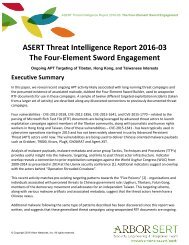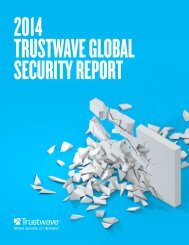Investigation of Linux.Mirai Trojan family
u97CXm
u97CXm
You also want an ePaper? Increase the reach of your titles
YUMPU automatically turns print PDFs into web optimized ePapers that Google loves.
51<br />
51<br />
.text:0804C218 push 9 ; sig<br />
.text:0804C21A neg [esp+1228h+var_120C]<br />
.text:0804C21E mov ecx, [esp+1228h+var_120C]<br />
.text:0804C222 push ecx ; int<br />
.text:0804C223 call ___GI_kill<br />
.text:0804C228 mov [esp+122Ch+fd], 0 ; status<br />
.text:0804C22F call ___GI_exit<br />
The MAC address <strong>of</strong> the network adapter is not sent to the C&C server, and network commands are received<br />
one by one.<br />
The run_scanner function, which was borrowed from the <strong>Linux</strong>.BackDoor.Fgt <strong>Trojan</strong> <strong>family</strong> and which is<br />
responsible for searching for vulnerable devices, has been slightly changed—the C&C server’s address,<br />
to which information on infected computers is sent, is extracted from the configuration.<br />
HTTP flood is now missing from the list <strong>of</strong> types <strong>of</strong> attacks performed, and commands have been reordered:<br />
Number<br />
Type<br />
0 UPD random<br />
1 TSource<br />
2 DNS flood<br />
3 TCP flood 2 options<br />
4 TCP flood random data<br />
5 TCP flood<br />
6 UDP over GRE<br />
7 TEB over GRE<br />
In the examined sample, virus makers tried to carry out a DNS amplification attack: the DNS server’s address<br />
is retrieved either from the resolv.conf file or from a list <strong>of</strong> public DNS servers hard-coded into the<br />
<strong>Trojan</strong>’s body.




